Crocodile Dundee: A Comical Portrayal of Australian Culture
VerifiedAdded on 2023/06/08
|8
|2863
|490
AI Summary
The article discusses the comical portrayal of Australian culture in the film Crocodile Dundee. It explores the elements of multiculturalism in Australian cinema and the issues related to national identity. The film is analyzed in terms of its representation of Indigenous culture, its use of stereotypes, and its portrayal of gender roles. The article also discusses the history of the Australian cinema industry and its impact on the country's culture.
Contribute Materials
Your contribution can guide someone’s learning journey. Share your
documents today.
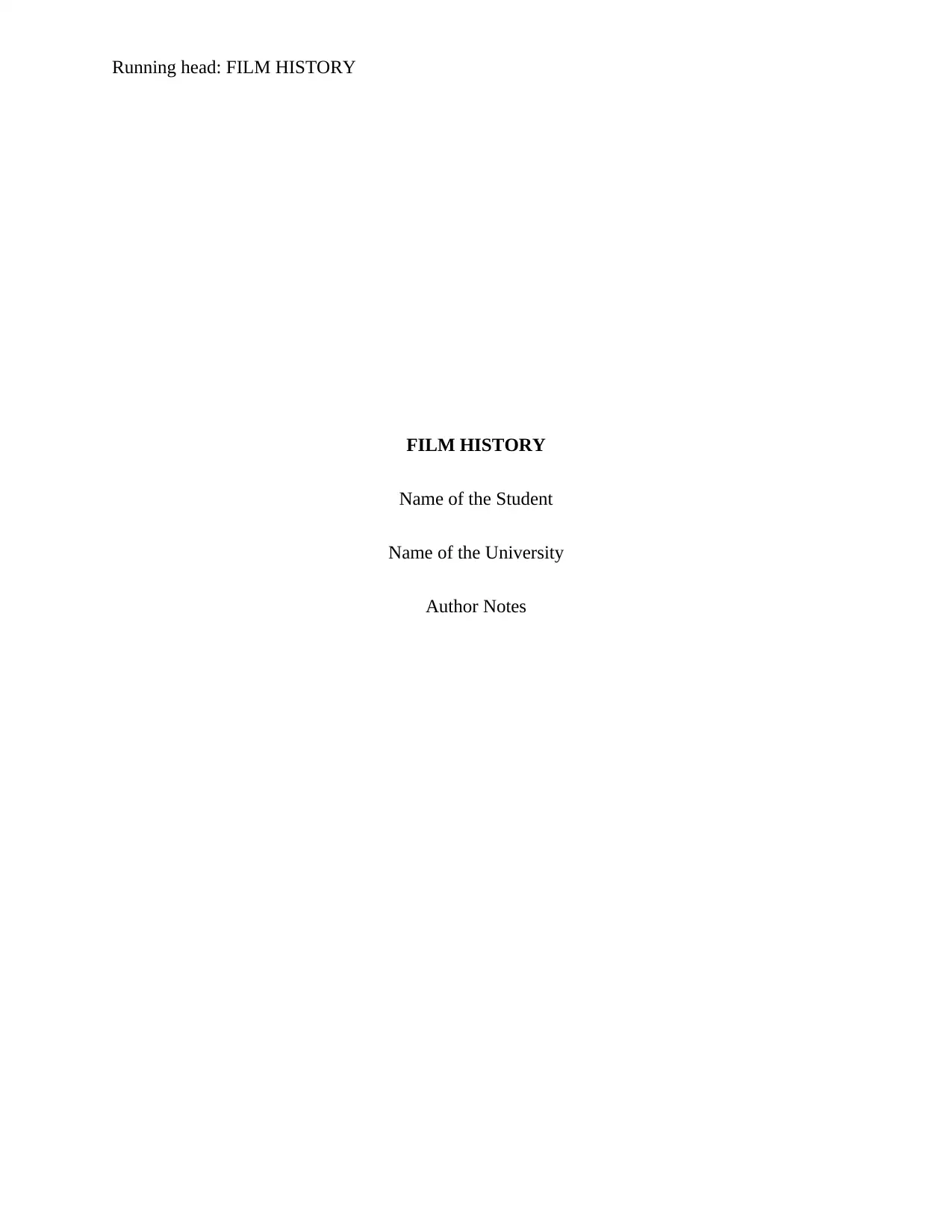
Running head: FILM HISTORY
FILM HISTORY
Name of the Student
Name of the University
Author Notes
FILM HISTORY
Name of the Student
Name of the University
Author Notes
Secure Best Marks with AI Grader
Need help grading? Try our AI Grader for instant feedback on your assignments.
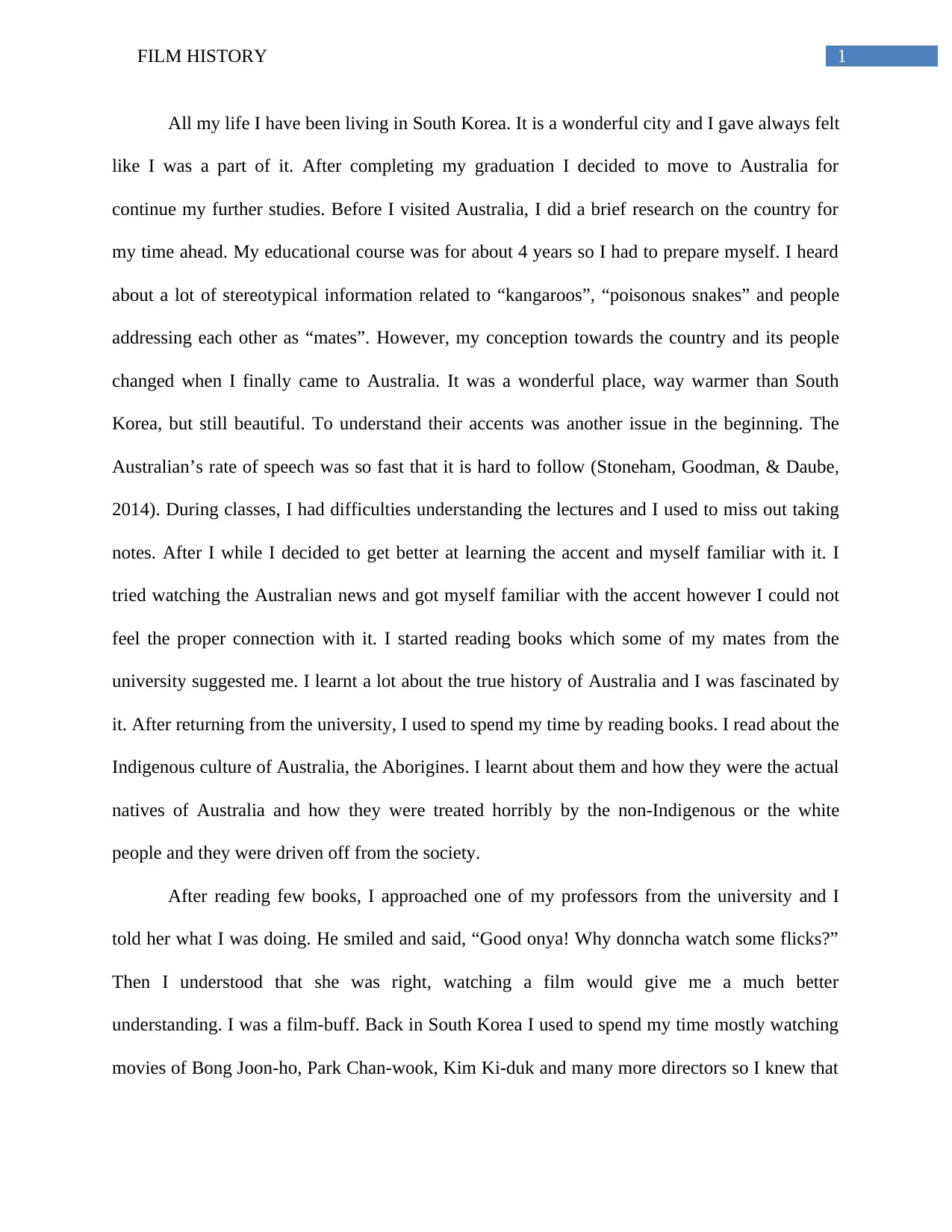
1FILM HISTORY
All my life I have been living in South Korea. It is a wonderful city and I gave always felt
like I was a part of it. After completing my graduation I decided to move to Australia for
continue my further studies. Before I visited Australia, I did a brief research on the country for
my time ahead. My educational course was for about 4 years so I had to prepare myself. I heard
about a lot of stereotypical information related to “kangaroos”, “poisonous snakes” and people
addressing each other as “mates”. However, my conception towards the country and its people
changed when I finally came to Australia. It was a wonderful place, way warmer than South
Korea, but still beautiful. To understand their accents was another issue in the beginning. The
Australian’s rate of speech was so fast that it is hard to follow (Stoneham, Goodman, & Daube,
2014). During classes, I had difficulties understanding the lectures and I used to miss out taking
notes. After I while I decided to get better at learning the accent and myself familiar with it. I
tried watching the Australian news and got myself familiar with the accent however I could not
feel the proper connection with it. I started reading books which some of my mates from the
university suggested me. I learnt a lot about the true history of Australia and I was fascinated by
it. After returning from the university, I used to spend my time by reading books. I read about the
Indigenous culture of Australia, the Aborigines. I learnt about them and how they were the actual
natives of Australia and how they were treated horribly by the non-Indigenous or the white
people and they were driven off from the society.
After reading few books, I approached one of my professors from the university and I
told her what I was doing. He smiled and said, “Good onya! Why donncha watch some flicks?”
Then I understood that she was right, watching a film would give me a much better
understanding. I was a film-buff. Back in South Korea I used to spend my time mostly watching
movies of Bong Joon-ho, Park Chan-wook, Kim Ki-duk and many more directors so I knew that
All my life I have been living in South Korea. It is a wonderful city and I gave always felt
like I was a part of it. After completing my graduation I decided to move to Australia for
continue my further studies. Before I visited Australia, I did a brief research on the country for
my time ahead. My educational course was for about 4 years so I had to prepare myself. I heard
about a lot of stereotypical information related to “kangaroos”, “poisonous snakes” and people
addressing each other as “mates”. However, my conception towards the country and its people
changed when I finally came to Australia. It was a wonderful place, way warmer than South
Korea, but still beautiful. To understand their accents was another issue in the beginning. The
Australian’s rate of speech was so fast that it is hard to follow (Stoneham, Goodman, & Daube,
2014). During classes, I had difficulties understanding the lectures and I used to miss out taking
notes. After I while I decided to get better at learning the accent and myself familiar with it. I
tried watching the Australian news and got myself familiar with the accent however I could not
feel the proper connection with it. I started reading books which some of my mates from the
university suggested me. I learnt a lot about the true history of Australia and I was fascinated by
it. After returning from the university, I used to spend my time by reading books. I read about the
Indigenous culture of Australia, the Aborigines. I learnt about them and how they were the actual
natives of Australia and how they were treated horribly by the non-Indigenous or the white
people and they were driven off from the society.
After reading few books, I approached one of my professors from the university and I
told her what I was doing. He smiled and said, “Good onya! Why donncha watch some flicks?”
Then I understood that she was right, watching a film would give me a much better
understanding. I was a film-buff. Back in South Korea I used to spend my time mostly watching
movies of Bong Joon-ho, Park Chan-wook, Kim Ki-duk and many more directors so I knew that
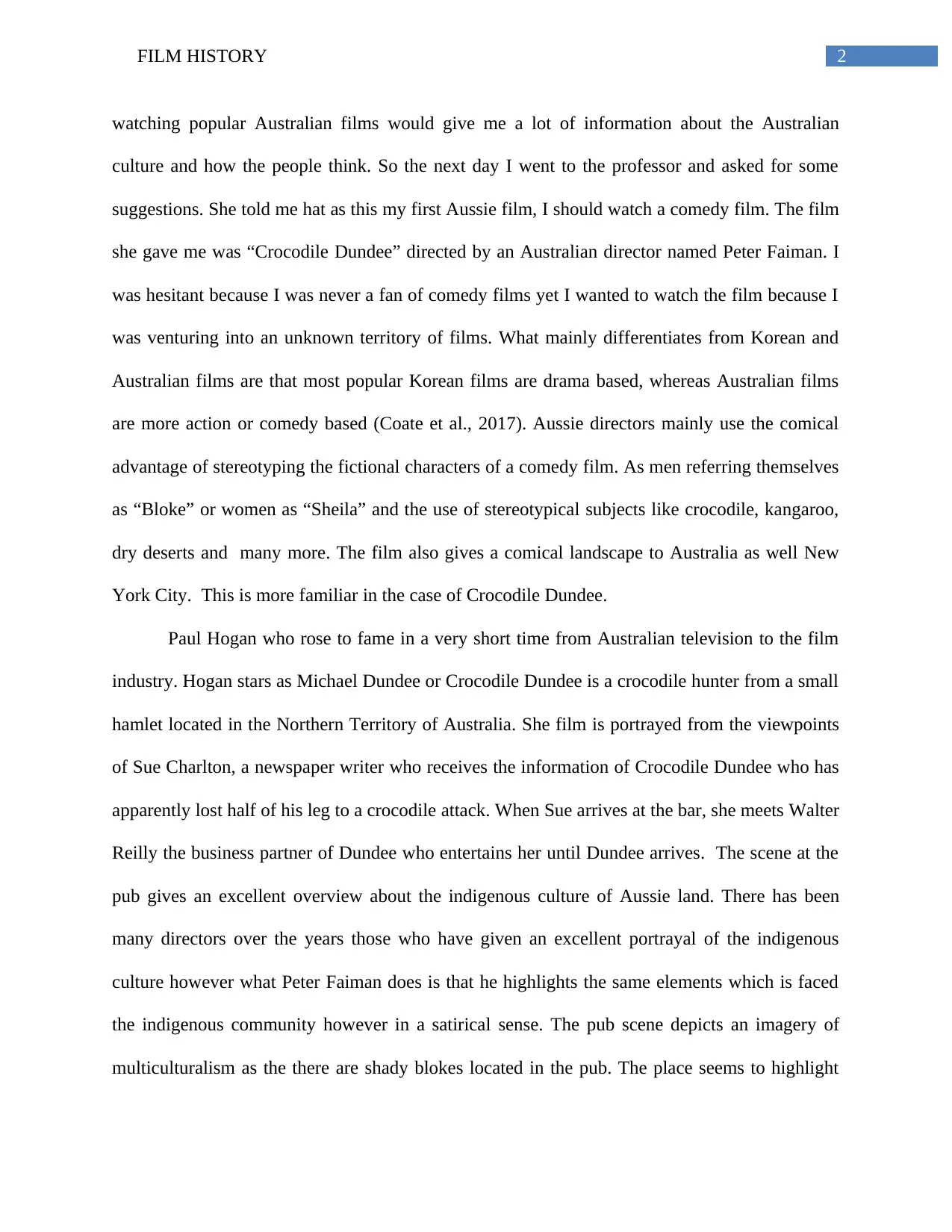
2FILM HISTORY
watching popular Australian films would give me a lot of information about the Australian
culture and how the people think. So the next day I went to the professor and asked for some
suggestions. She told me hat as this my first Aussie film, I should watch a comedy film. The film
she gave me was “Crocodile Dundee” directed by an Australian director named Peter Faiman. I
was hesitant because I was never a fan of comedy films yet I wanted to watch the film because I
was venturing into an unknown territory of films. What mainly differentiates from Korean and
Australian films are that most popular Korean films are drama based, whereas Australian films
are more action or comedy based (Coate et al., 2017). Aussie directors mainly use the comical
advantage of stereotyping the fictional characters of a comedy film. As men referring themselves
as “Bloke” or women as “Sheila” and the use of stereotypical subjects like crocodile, kangaroo,
dry deserts and many more. The film also gives a comical landscape to Australia as well New
York City. This is more familiar in the case of Crocodile Dundee.
Paul Hogan who rose to fame in a very short time from Australian television to the film
industry. Hogan stars as Michael Dundee or Crocodile Dundee is a crocodile hunter from a small
hamlet located in the Northern Territory of Australia. She film is portrayed from the viewpoints
of Sue Charlton, a newspaper writer who receives the information of Crocodile Dundee who has
apparently lost half of his leg to a crocodile attack. When Sue arrives at the bar, she meets Walter
Reilly the business partner of Dundee who entertains her until Dundee arrives. The scene at the
pub gives an excellent overview about the indigenous culture of Aussie land. There has been
many directors over the years those who have given an excellent portrayal of the indigenous
culture however what Peter Faiman does is that he highlights the same elements which is faced
the indigenous community however in a satirical sense. The pub scene depicts an imagery of
multiculturalism as the there are shady blokes located in the pub. The place seems to highlight
watching popular Australian films would give me a lot of information about the Australian
culture and how the people think. So the next day I went to the professor and asked for some
suggestions. She told me hat as this my first Aussie film, I should watch a comedy film. The film
she gave me was “Crocodile Dundee” directed by an Australian director named Peter Faiman. I
was hesitant because I was never a fan of comedy films yet I wanted to watch the film because I
was venturing into an unknown territory of films. What mainly differentiates from Korean and
Australian films are that most popular Korean films are drama based, whereas Australian films
are more action or comedy based (Coate et al., 2017). Aussie directors mainly use the comical
advantage of stereotyping the fictional characters of a comedy film. As men referring themselves
as “Bloke” or women as “Sheila” and the use of stereotypical subjects like crocodile, kangaroo,
dry deserts and many more. The film also gives a comical landscape to Australia as well New
York City. This is more familiar in the case of Crocodile Dundee.
Paul Hogan who rose to fame in a very short time from Australian television to the film
industry. Hogan stars as Michael Dundee or Crocodile Dundee is a crocodile hunter from a small
hamlet located in the Northern Territory of Australia. She film is portrayed from the viewpoints
of Sue Charlton, a newspaper writer who receives the information of Crocodile Dundee who has
apparently lost half of his leg to a crocodile attack. When Sue arrives at the bar, she meets Walter
Reilly the business partner of Dundee who entertains her until Dundee arrives. The scene at the
pub gives an excellent overview about the indigenous culture of Aussie land. There has been
many directors over the years those who have given an excellent portrayal of the indigenous
culture however what Peter Faiman does is that he highlights the same elements which is faced
the indigenous community however in a satirical sense. The pub scene depicts an imagery of
multiculturalism as the there are shady blokes located in the pub. The place seems to highlight
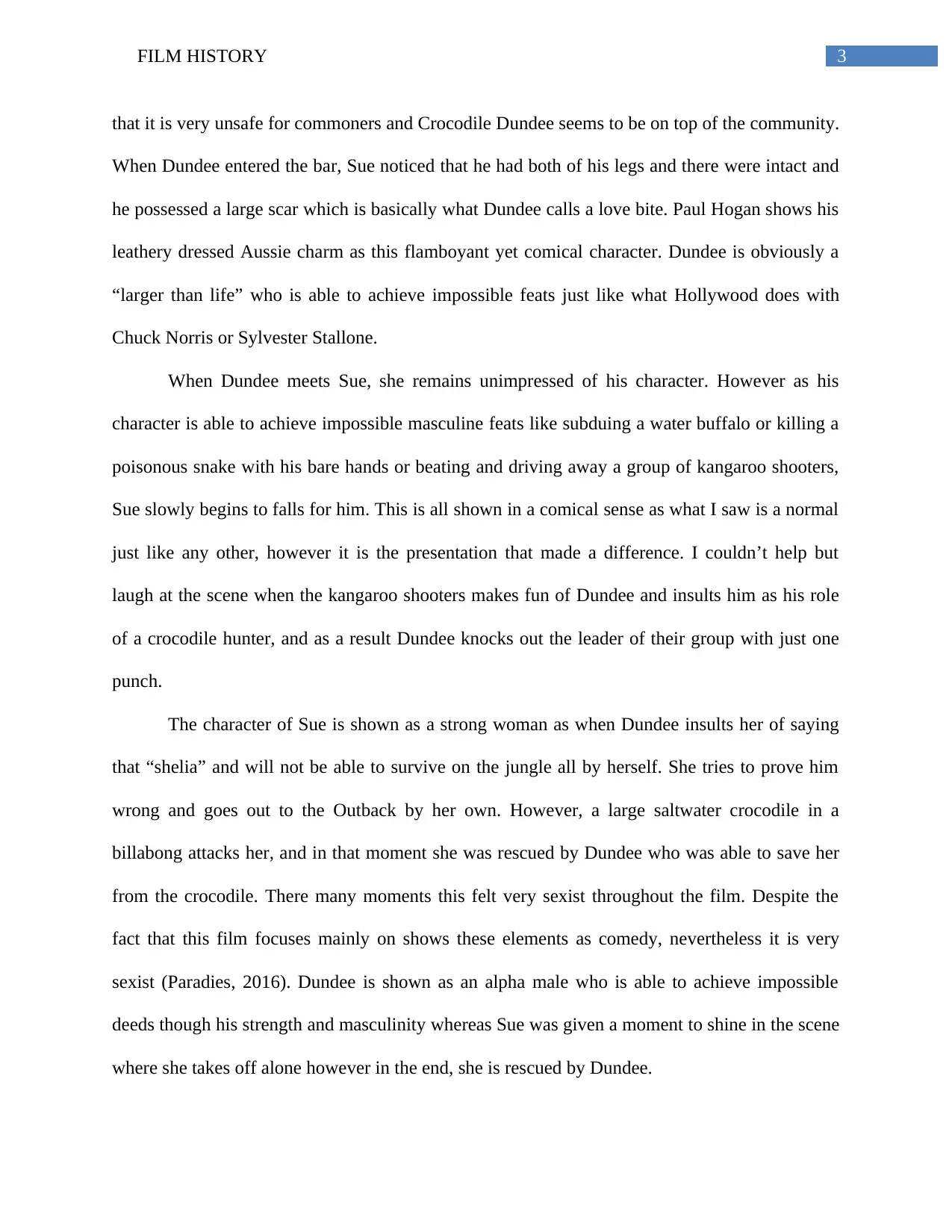
3FILM HISTORY
that it is very unsafe for commoners and Crocodile Dundee seems to be on top of the community.
When Dundee entered the bar, Sue noticed that he had both of his legs and there were intact and
he possessed a large scar which is basically what Dundee calls a love bite. Paul Hogan shows his
leathery dressed Aussie charm as this flamboyant yet comical character. Dundee is obviously a
“larger than life” who is able to achieve impossible feats just like what Hollywood does with
Chuck Norris or Sylvester Stallone.
When Dundee meets Sue, she remains unimpressed of his character. However as his
character is able to achieve impossible masculine feats like subduing a water buffalo or killing a
poisonous snake with his bare hands or beating and driving away a group of kangaroo shooters,
Sue slowly begins to falls for him. This is all shown in a comical sense as what I saw is a normal
just like any other, however it is the presentation that made a difference. I couldn’t help but
laugh at the scene when the kangaroo shooters makes fun of Dundee and insults him as his role
of a crocodile hunter, and as a result Dundee knocks out the leader of their group with just one
punch.
The character of Sue is shown as a strong woman as when Dundee insults her of saying
that “shelia” and will not be able to survive on the jungle all by herself. She tries to prove him
wrong and goes out to the Outback by her own. However, a large saltwater crocodile in a
billabong attacks her, and in that moment she was rescued by Dundee who was able to save her
from the crocodile. There many moments this felt very sexist throughout the film. Despite the
fact that this film focuses mainly on shows these elements as comedy, nevertheless it is very
sexist (Paradies, 2016). Dundee is shown as an alpha male who is able to achieve impossible
deeds though his strength and masculinity whereas Sue was given a moment to shine in the scene
where she takes off alone however in the end, she is rescued by Dundee.
that it is very unsafe for commoners and Crocodile Dundee seems to be on top of the community.
When Dundee entered the bar, Sue noticed that he had both of his legs and there were intact and
he possessed a large scar which is basically what Dundee calls a love bite. Paul Hogan shows his
leathery dressed Aussie charm as this flamboyant yet comical character. Dundee is obviously a
“larger than life” who is able to achieve impossible feats just like what Hollywood does with
Chuck Norris or Sylvester Stallone.
When Dundee meets Sue, she remains unimpressed of his character. However as his
character is able to achieve impossible masculine feats like subduing a water buffalo or killing a
poisonous snake with his bare hands or beating and driving away a group of kangaroo shooters,
Sue slowly begins to falls for him. This is all shown in a comical sense as what I saw is a normal
just like any other, however it is the presentation that made a difference. I couldn’t help but
laugh at the scene when the kangaroo shooters makes fun of Dundee and insults him as his role
of a crocodile hunter, and as a result Dundee knocks out the leader of their group with just one
punch.
The character of Sue is shown as a strong woman as when Dundee insults her of saying
that “shelia” and will not be able to survive on the jungle all by herself. She tries to prove him
wrong and goes out to the Outback by her own. However, a large saltwater crocodile in a
billabong attacks her, and in that moment she was rescued by Dundee who was able to save her
from the crocodile. There many moments this felt very sexist throughout the film. Despite the
fact that this film focuses mainly on shows these elements as comedy, nevertheless it is very
sexist (Paradies, 2016). Dundee is shown as an alpha male who is able to achieve impossible
deeds though his strength and masculinity whereas Sue was given a moment to shine in the scene
where she takes off alone however in the end, she is rescued by Dundee.
Secure Best Marks with AI Grader
Need help grading? Try our AI Grader for instant feedback on your assignments.
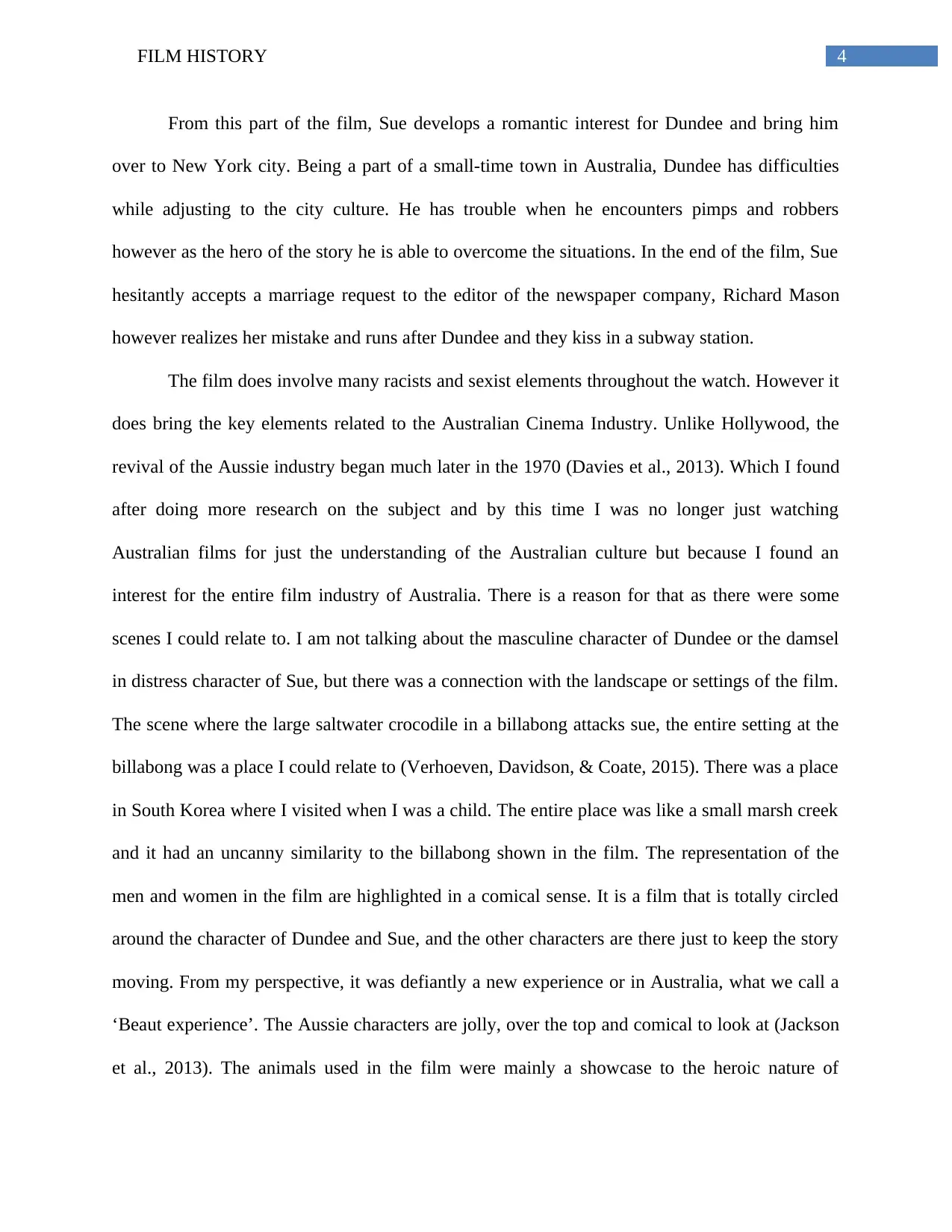
4FILM HISTORY
From this part of the film, Sue develops a romantic interest for Dundee and bring him
over to New York city. Being a part of a small-time town in Australia, Dundee has difficulties
while adjusting to the city culture. He has trouble when he encounters pimps and robbers
however as the hero of the story he is able to overcome the situations. In the end of the film, Sue
hesitantly accepts a marriage request to the editor of the newspaper company, Richard Mason
however realizes her mistake and runs after Dundee and they kiss in a subway station.
The film does involve many racists and sexist elements throughout the watch. However it
does bring the key elements related to the Australian Cinema Industry. Unlike Hollywood, the
revival of the Aussie industry began much later in the 1970 (Davies et al., 2013). Which I found
after doing more research on the subject and by this time I was no longer just watching
Australian films for just the understanding of the Australian culture but because I found an
interest for the entire film industry of Australia. There is a reason for that as there were some
scenes I could relate to. I am not talking about the masculine character of Dundee or the damsel
in distress character of Sue, but there was a connection with the landscape or settings of the film.
The scene where the large saltwater crocodile in a billabong attacks sue, the entire setting at the
billabong was a place I could relate to (Verhoeven, Davidson, & Coate, 2015). There was a place
in South Korea where I visited when I was a child. The entire place was like a small marsh creek
and it had an uncanny similarity to the billabong shown in the film. The representation of the
men and women in the film are highlighted in a comical sense. It is a film that is totally circled
around the character of Dundee and Sue, and the other characters are there just to keep the story
moving. From my perspective, it was defiantly a new experience or in Australia, what we call a
‘Beaut experience’. The Aussie characters are jolly, over the top and comical to look at (Jackson
et al., 2013). The animals used in the film were mainly a showcase to the heroic nature of
From this part of the film, Sue develops a romantic interest for Dundee and bring him
over to New York city. Being a part of a small-time town in Australia, Dundee has difficulties
while adjusting to the city culture. He has trouble when he encounters pimps and robbers
however as the hero of the story he is able to overcome the situations. In the end of the film, Sue
hesitantly accepts a marriage request to the editor of the newspaper company, Richard Mason
however realizes her mistake and runs after Dundee and they kiss in a subway station.
The film does involve many racists and sexist elements throughout the watch. However it
does bring the key elements related to the Australian Cinema Industry. Unlike Hollywood, the
revival of the Aussie industry began much later in the 1970 (Davies et al., 2013). Which I found
after doing more research on the subject and by this time I was no longer just watching
Australian films for just the understanding of the Australian culture but because I found an
interest for the entire film industry of Australia. There is a reason for that as there were some
scenes I could relate to. I am not talking about the masculine character of Dundee or the damsel
in distress character of Sue, but there was a connection with the landscape or settings of the film.
The scene where the large saltwater crocodile in a billabong attacks sue, the entire setting at the
billabong was a place I could relate to (Verhoeven, Davidson, & Coate, 2015). There was a place
in South Korea where I visited when I was a child. The entire place was like a small marsh creek
and it had an uncanny similarity to the billabong shown in the film. The representation of the
men and women in the film are highlighted in a comical sense. It is a film that is totally circled
around the character of Dundee and Sue, and the other characters are there just to keep the story
moving. From my perspective, it was defiantly a new experience or in Australia, what we call a
‘Beaut experience’. The Aussie characters are jolly, over the top and comical to look at (Jackson
et al., 2013). The animals used in the film were mainly a showcase to the heroic nature of
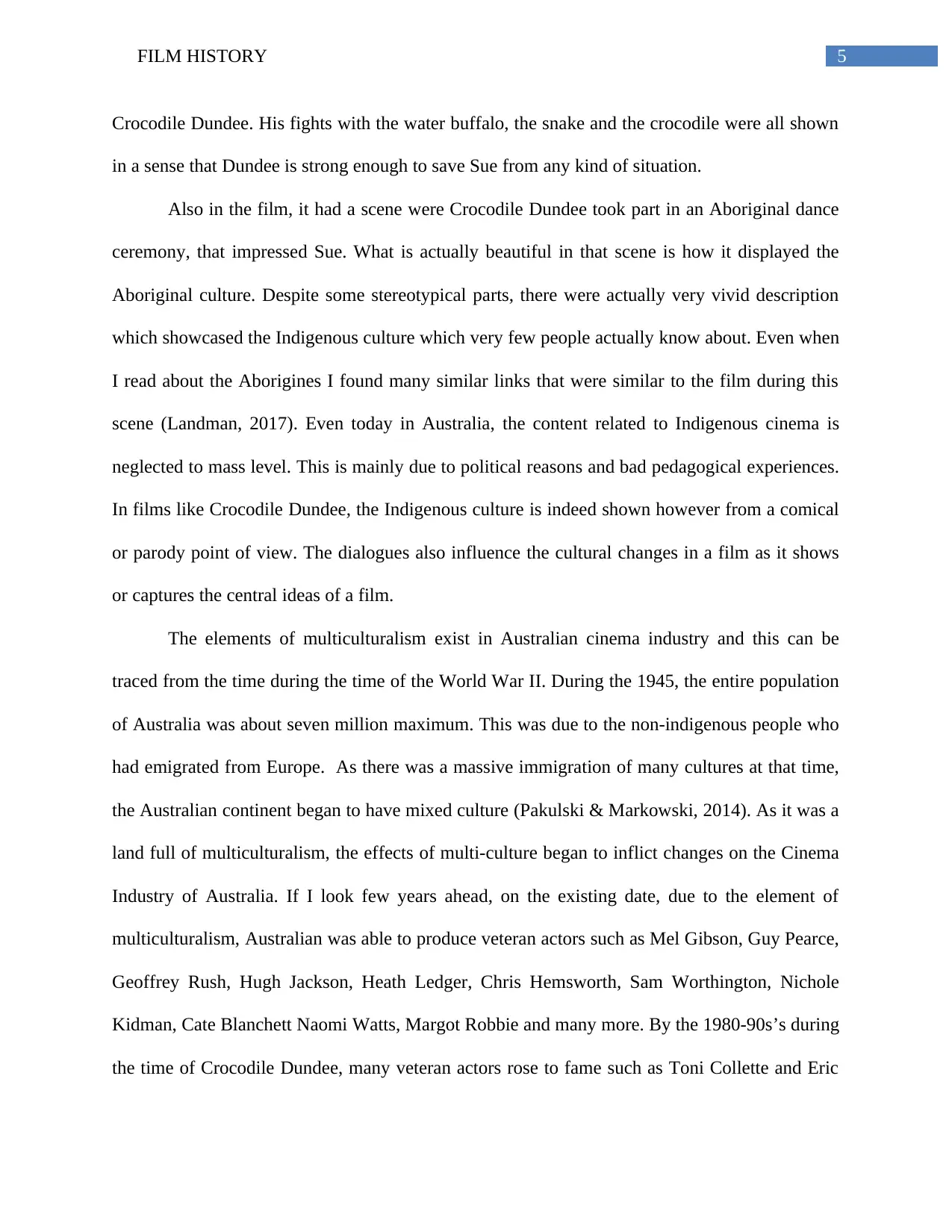
5FILM HISTORY
Crocodile Dundee. His fights with the water buffalo, the snake and the crocodile were all shown
in a sense that Dundee is strong enough to save Sue from any kind of situation.
Also in the film, it had a scene were Crocodile Dundee took part in an Aboriginal dance
ceremony, that impressed Sue. What is actually beautiful in that scene is how it displayed the
Aboriginal culture. Despite some stereotypical parts, there were actually very vivid description
which showcased the Indigenous culture which very few people actually know about. Even when
I read about the Aborigines I found many similar links that were similar to the film during this
scene (Landman, 2017). Even today in Australia, the content related to Indigenous cinema is
neglected to mass level. This is mainly due to political reasons and bad pedagogical experiences.
In films like Crocodile Dundee, the Indigenous culture is indeed shown however from a comical
or parody point of view. The dialogues also influence the cultural changes in a film as it shows
or captures the central ideas of a film.
The elements of multiculturalism exist in Australian cinema industry and this can be
traced from the time during the time of the World War II. During the 1945, the entire population
of Australia was about seven million maximum. This was due to the non-indigenous people who
had emigrated from Europe. As there was a massive immigration of many cultures at that time,
the Australian continent began to have mixed culture (Pakulski & Markowski, 2014). As it was a
land full of multiculturalism, the effects of multi-culture began to inflict changes on the Cinema
Industry of Australia. If I look few years ahead, on the existing date, due to the element of
multiculturalism, Australian was able to produce veteran actors such as Mel Gibson, Guy Pearce,
Geoffrey Rush, Hugh Jackson, Heath Ledger, Chris Hemsworth, Sam Worthington, Nichole
Kidman, Cate Blanchett Naomi Watts, Margot Robbie and many more. By the 1980-90s’s during
the time of Crocodile Dundee, many veteran actors rose to fame such as Toni Collette and Eric
Crocodile Dundee. His fights with the water buffalo, the snake and the crocodile were all shown
in a sense that Dundee is strong enough to save Sue from any kind of situation.
Also in the film, it had a scene were Crocodile Dundee took part in an Aboriginal dance
ceremony, that impressed Sue. What is actually beautiful in that scene is how it displayed the
Aboriginal culture. Despite some stereotypical parts, there were actually very vivid description
which showcased the Indigenous culture which very few people actually know about. Even when
I read about the Aborigines I found many similar links that were similar to the film during this
scene (Landman, 2017). Even today in Australia, the content related to Indigenous cinema is
neglected to mass level. This is mainly due to political reasons and bad pedagogical experiences.
In films like Crocodile Dundee, the Indigenous culture is indeed shown however from a comical
or parody point of view. The dialogues also influence the cultural changes in a film as it shows
or captures the central ideas of a film.
The elements of multiculturalism exist in Australian cinema industry and this can be
traced from the time during the time of the World War II. During the 1945, the entire population
of Australia was about seven million maximum. This was due to the non-indigenous people who
had emigrated from Europe. As there was a massive immigration of many cultures at that time,
the Australian continent began to have mixed culture (Pakulski & Markowski, 2014). As it was a
land full of multiculturalism, the effects of multi-culture began to inflict changes on the Cinema
Industry of Australia. If I look few years ahead, on the existing date, due to the element of
multiculturalism, Australian was able to produce veteran actors such as Mel Gibson, Guy Pearce,
Geoffrey Rush, Hugh Jackson, Heath Ledger, Chris Hemsworth, Sam Worthington, Nichole
Kidman, Cate Blanchett Naomi Watts, Margot Robbie and many more. By the 1980-90s’s during
the time of Crocodile Dundee, many veteran actors rose to fame such as Toni Collette and Eric
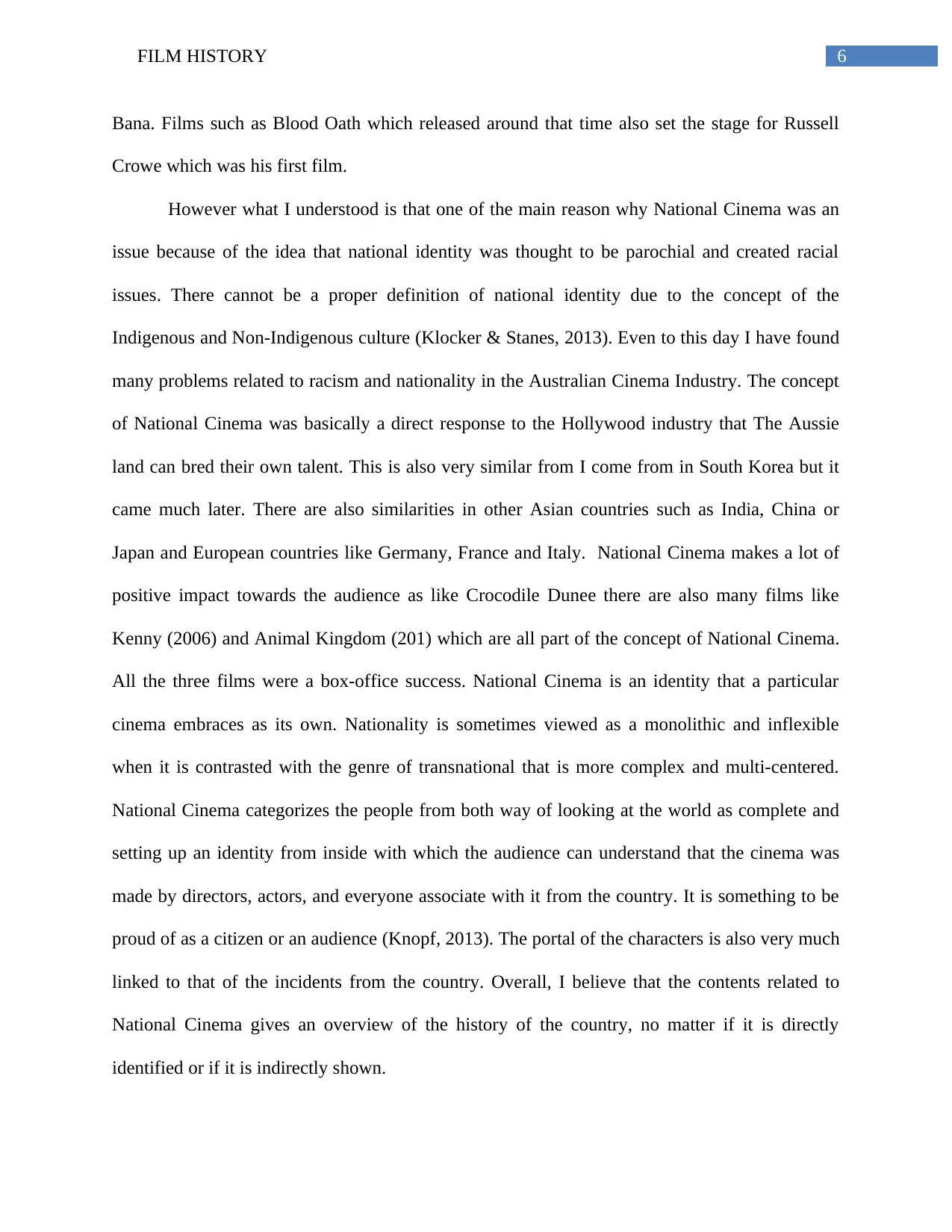
6FILM HISTORY
Bana. Films such as Blood Oath which released around that time also set the stage for Russell
Crowe which was his first film.
However what I understood is that one of the main reason why National Cinema was an
issue because of the idea that national identity was thought to be parochial and created racial
issues. There cannot be a proper definition of national identity due to the concept of the
Indigenous and Non-Indigenous culture (Klocker & Stanes, 2013). Even to this day I have found
many problems related to racism and nationality in the Australian Cinema Industry. The concept
of National Cinema was basically a direct response to the Hollywood industry that The Aussie
land can bred their own talent. This is also very similar from I come from in South Korea but it
came much later. There are also similarities in other Asian countries such as India, China or
Japan and European countries like Germany, France and Italy. National Cinema makes a lot of
positive impact towards the audience as like Crocodile Dunee there are also many films like
Kenny (2006) and Animal Kingdom (201) which are all part of the concept of National Cinema.
All the three films were a box-office success. National Cinema is an identity that a particular
cinema embraces as its own. Nationality is sometimes viewed as a monolithic and inflexible
when it is contrasted with the genre of transnational that is more complex and multi-centered.
National Cinema categorizes the people from both way of looking at the world as complete and
setting up an identity from inside with which the audience can understand that the cinema was
made by directors, actors, and everyone associate with it from the country. It is something to be
proud of as a citizen or an audience (Knopf, 2013). The portal of the characters is also very much
linked to that of the incidents from the country. Overall, I believe that the contents related to
National Cinema gives an overview of the history of the country, no matter if it is directly
identified or if it is indirectly shown.
Bana. Films such as Blood Oath which released around that time also set the stage for Russell
Crowe which was his first film.
However what I understood is that one of the main reason why National Cinema was an
issue because of the idea that national identity was thought to be parochial and created racial
issues. There cannot be a proper definition of national identity due to the concept of the
Indigenous and Non-Indigenous culture (Klocker & Stanes, 2013). Even to this day I have found
many problems related to racism and nationality in the Australian Cinema Industry. The concept
of National Cinema was basically a direct response to the Hollywood industry that The Aussie
land can bred their own talent. This is also very similar from I come from in South Korea but it
came much later. There are also similarities in other Asian countries such as India, China or
Japan and European countries like Germany, France and Italy. National Cinema makes a lot of
positive impact towards the audience as like Crocodile Dunee there are also many films like
Kenny (2006) and Animal Kingdom (201) which are all part of the concept of National Cinema.
All the three films were a box-office success. National Cinema is an identity that a particular
cinema embraces as its own. Nationality is sometimes viewed as a monolithic and inflexible
when it is contrasted with the genre of transnational that is more complex and multi-centered.
National Cinema categorizes the people from both way of looking at the world as complete and
setting up an identity from inside with which the audience can understand that the cinema was
made by directors, actors, and everyone associate with it from the country. It is something to be
proud of as a citizen or an audience (Knopf, 2013). The portal of the characters is also very much
linked to that of the incidents from the country. Overall, I believe that the contents related to
National Cinema gives an overview of the history of the country, no matter if it is directly
identified or if it is indirectly shown.
Paraphrase This Document
Need a fresh take? Get an instant paraphrase of this document with our AI Paraphraser
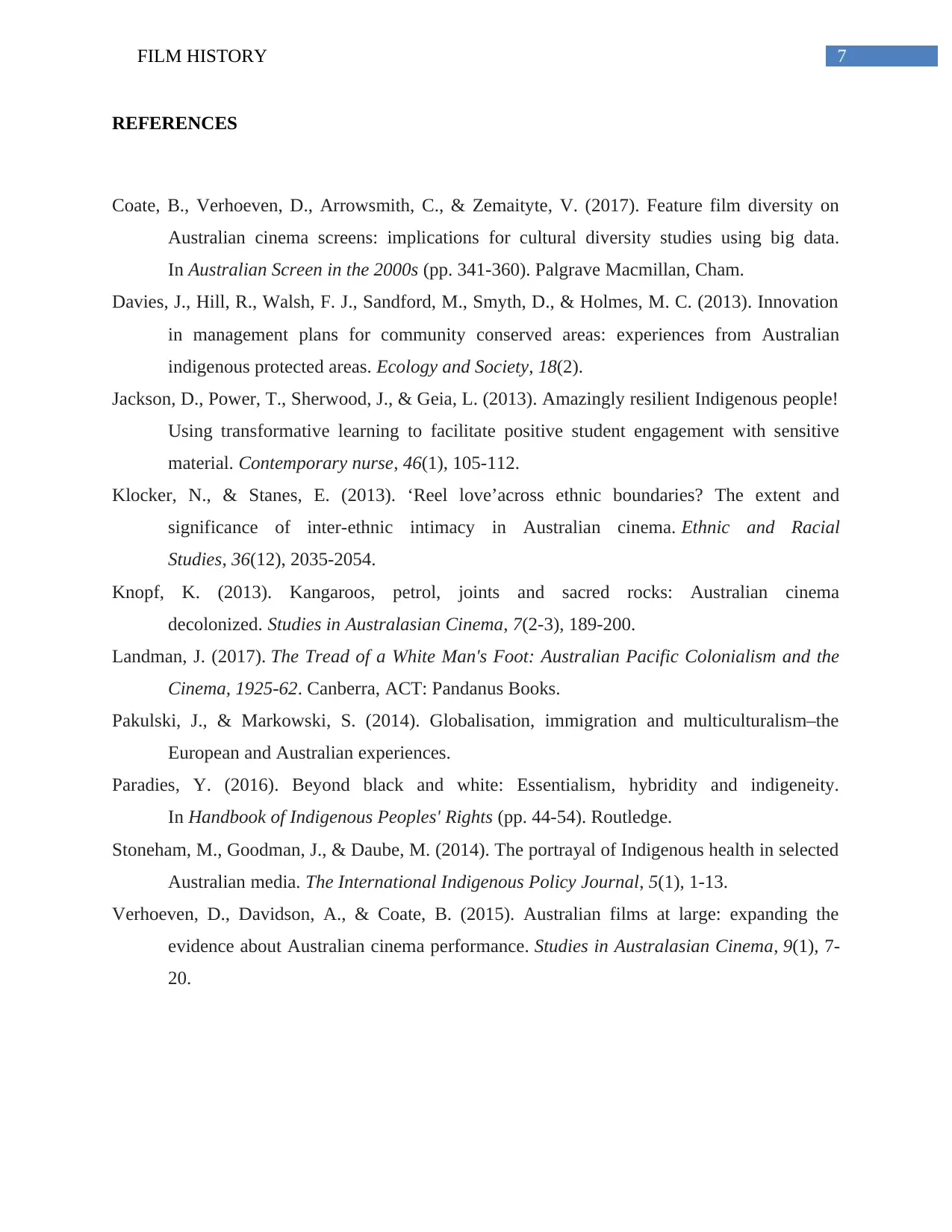
7FILM HISTORY
REFERENCES
Coate, B., Verhoeven, D., Arrowsmith, C., & Zemaityte, V. (2017). Feature film diversity on
Australian cinema screens: implications for cultural diversity studies using big data.
In Australian Screen in the 2000s (pp. 341-360). Palgrave Macmillan, Cham.
Davies, J., Hill, R., Walsh, F. J., Sandford, M., Smyth, D., & Holmes, M. C. (2013). Innovation
in management plans for community conserved areas: experiences from Australian
indigenous protected areas. Ecology and Society, 18(2).
Jackson, D., Power, T., Sherwood, J., & Geia, L. (2013). Amazingly resilient Indigenous people!
Using transformative learning to facilitate positive student engagement with sensitive
material. Contemporary nurse, 46(1), 105-112.
Klocker, N., & Stanes, E. (2013). ‘Reel love’across ethnic boundaries? The extent and
significance of inter-ethnic intimacy in Australian cinema. Ethnic and Racial
Studies, 36(12), 2035-2054.
Knopf, K. (2013). Kangaroos, petrol, joints and sacred rocks: Australian cinema
decolonized. Studies in Australasian Cinema, 7(2-3), 189-200.
Landman, J. (2017). The Tread of a White Man's Foot: Australian Pacific Colonialism and the
Cinema, 1925-62. Canberra, ACT: Pandanus Books.
Pakulski, J., & Markowski, S. (2014). Globalisation, immigration and multiculturalism–the
European and Australian experiences.
Paradies, Y. (2016). Beyond black and white: Essentialism, hybridity and indigeneity.
In Handbook of Indigenous Peoples' Rights (pp. 44-54). Routledge.
Stoneham, M., Goodman, J., & Daube, M. (2014). The portrayal of Indigenous health in selected
Australian media. The International Indigenous Policy Journal, 5(1), 1-13.
Verhoeven, D., Davidson, A., & Coate, B. (2015). Australian films at large: expanding the
evidence about Australian cinema performance. Studies in Australasian Cinema, 9(1), 7-
20.
REFERENCES
Coate, B., Verhoeven, D., Arrowsmith, C., & Zemaityte, V. (2017). Feature film diversity on
Australian cinema screens: implications for cultural diversity studies using big data.
In Australian Screen in the 2000s (pp. 341-360). Palgrave Macmillan, Cham.
Davies, J., Hill, R., Walsh, F. J., Sandford, M., Smyth, D., & Holmes, M. C. (2013). Innovation
in management plans for community conserved areas: experiences from Australian
indigenous protected areas. Ecology and Society, 18(2).
Jackson, D., Power, T., Sherwood, J., & Geia, L. (2013). Amazingly resilient Indigenous people!
Using transformative learning to facilitate positive student engagement with sensitive
material. Contemporary nurse, 46(1), 105-112.
Klocker, N., & Stanes, E. (2013). ‘Reel love’across ethnic boundaries? The extent and
significance of inter-ethnic intimacy in Australian cinema. Ethnic and Racial
Studies, 36(12), 2035-2054.
Knopf, K. (2013). Kangaroos, petrol, joints and sacred rocks: Australian cinema
decolonized. Studies in Australasian Cinema, 7(2-3), 189-200.
Landman, J. (2017). The Tread of a White Man's Foot: Australian Pacific Colonialism and the
Cinema, 1925-62. Canberra, ACT: Pandanus Books.
Pakulski, J., & Markowski, S. (2014). Globalisation, immigration and multiculturalism–the
European and Australian experiences.
Paradies, Y. (2016). Beyond black and white: Essentialism, hybridity and indigeneity.
In Handbook of Indigenous Peoples' Rights (pp. 44-54). Routledge.
Stoneham, M., Goodman, J., & Daube, M. (2014). The portrayal of Indigenous health in selected
Australian media. The International Indigenous Policy Journal, 5(1), 1-13.
Verhoeven, D., Davidson, A., & Coate, B. (2015). Australian films at large: expanding the
evidence about Australian cinema performance. Studies in Australasian Cinema, 9(1), 7-
20.
1 out of 8
Your All-in-One AI-Powered Toolkit for Academic Success.
+13062052269
info@desklib.com
Available 24*7 on WhatsApp / Email
![[object Object]](/_next/static/media/star-bottom.7253800d.svg)
Unlock your academic potential
© 2024 | Zucol Services PVT LTD | All rights reserved.



